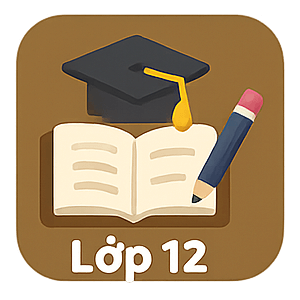Giáo án tiếng Anh lớp 12 Tuần 12 sách mới
Giáo án tiếng Anh lớp 12 chương trình mới Tuần 12
Nằm trong tài liệu Giáo án môn Tiếng Anh 12 theo tuần, Soạn Giáo án tiếng Anh Tuần 12 liên quan đến Lesson 5 Listening; Lesson 6 Writing; Lesson 7 Communication and Culture Unit 4 The Mass Media ... được trình bày chi tiết và khoa học giúp giáo viên chuẩn bị bài giảng hiệu quả.
TIẾT 34: UNIT 4: THE MASS MEDIA
LESSON 5. LISTENING
A. Aims and Objectives: - To develop Ss’ skill of listening to for general ideas and specific information in a conversation about social media: language-learning apps
- To help Ss understand general ideas and specific details to answer comprehension questions.
- By the end of the lesson, students will be able to:
+ Listen and do the tasks.
+ Develop the listening skills for specific details.
+ Identify specific information through multiple-choice task and question answering
B. Preparations: - Teacher: Handouts, textbook, pieces of papers and cassette.
- Students: Textbook
1. Methods: - The whole lesson: Integrated, mainly communicative.
2. Procedures:
|
Time/Stages |
Activities |
Interactions |
|
1. Lead-in 7 minutes |
Inform the class of the lesson objectives: listening for specific information in a conversation between two students talking about their uses of social media and how they use it for language learning. |
T <--> Ss
|
|
2. New lesson
10 minutes
13 minutes
12 minutes
|
Social media: language-learning apps Task 1: Read about how three students use social media. Complete the sentences with the words from the box. - T allows time for Ss to quickly read the conversation and complete the gapped sentences. - T checks answers as a class. Key: 1. app 2. record 3. GPS 4. interactive 5. connect 6. audio 7. updates Task 2: Listen to a conversation between two students talking about language learning applications. Which of the following did they not talk about? - T asks Ss to read the instructions and the information provided. - T plays the recording without pausing, so Ss get the gist of it. - T plays the recording again. This time T asks Ss to listen and circle the information that they did not hear in the recording. Key : 2 & 3 Task 3: Listen again. Give short answers to the following questions. - T asks Ss to read through the questions and answer them. - Ss do as required. Key: 1. He showed her a few social networking sites that help people to improve their English. 2. She downloaded some language learning apps on her smartphone and started learning vocabulary on the go. 3. Because she wants to improve her English. 4. She uses some social networking sites. 5. She used a free programme on her smartphone. 6. She used it to collect samples from English TV and radio. |
Pair work
T <--> Ss
Group work
T <--> Ss
Individually
T <--> Ss
|
|
3. Consolidation 2 minutes |
- Ask Ss to consolidate the main contents. - Ask Ss: What have you learnt today? What can you do now? |
T <--> Ss |
|
4. Homework 1 minute |
- Prepare for the next lesson. |
T <--> Ss |
E. Evaluation:
......................................................................................................................................................
TIẾT 35: UNIT 4: THE MASS MEDIA
LESSON 6. WRITING
A. Aims and Objectives:
- To develop Ss’ skill of describing a pie chart showing the use of online resources.
- To provide Ss with the language and sentence structures used to describe trends.
- By the end of the lesson, students will be able to:
+ Learn about a pie chart showing the use of online resources.
+ Describe a pie chart showing the use of online resources.
+ Develop the writing skills in general. Build up vocabulary supported for writing.
B. Preparations: - Teacher: Handouts, textbook, lesson plan and pieces of papers.
- Students: Textbook
C. Methods: - The whole lesson: Integrated, mainly communicative.
D. Procedures:
|
Time/Stages |
Activities |
Interactions |
|
1. Check up 5 minutes |
The lesson objective: describing a pie chart showing Ss’ use of online resources at a secondary school. |
T <--> Ss
|
|
2. New lesson
15 minutes
8 minutes
|
Describing a pie chart showing the use of online resources Task 1: In pairs, discuss what a pie chart is and how you can describe it. - T asks Ss to look at the illustrations and credit their answers. - Sts do as required. + A pie chart - a circular chart divided into triangular areas (slices/ segments) proportional to the percentages of the whole. + To describe a pie chart: the information (content) and proportion of each segment, which can be measured in percentages (%) or fraction (e.g. one-third, a quarter). Task 2: The pie chart below illustrates the forms of communication used by students in Intel school. Complete the description with the words in the box. - T allows time for Ss to read the text and do the task. - T checks answer as a class. Key: 1. preferences 2. recorded 3. majority 4. tied in 5. dominant 6. the least Task 3: Study the pie chart and write a paragraph of about 130-160 words to describe the sections. - T asks Ss to work in pairs and discuss the words and phrases. - Sts work independently and write their final drafts. - One or two students write the description on the board. - Ss listen to the T’ feedback Suggested answer: The pie chart shows students’ preferred online resources recorded in a survey carried out at Intel Secondary School Library in 2014. A brief description of the students’ preferences follows. We can see that a majority of students used interactive games, which rank the first at 30%. Fiction e-books line in the second at 20%, and are given 10% less than interactive games. Online magazines rank the third at 18% while non-fiction e-books account for 15%. Online dictionaries are the fifth library resource at 11%. Only a minority of students, or 6% used science journals, which is the least popular of all resources, and used five old less than the most preferred resource, interactive games. To conclude, the dominant form of online resources used by the students at Intel Secondary School Library is interactive games. Of all the resources – fiction e-books, online magazines, non-fiction e-books, online dictionaries – students used science journals the least. |
Pair work
T <--> Ss
Individually
T <--> Ss
|
|
3. Consolidation 2 minutes |
- Ask Ss to consolidate the main contents. - Ask Ss to complete the writing at home and collect - Ask Ss: What have you learnt today? What can you do now? |
T <--> Ss |
|
4.Homework 1 minute |
- Write the text again at home. - Prepare for the next lesson. |
T <--> Ss |
E. Evaluation:
......................................................................................................................................................
TIẾT 36: UNIT 4: THE MASS MEDIA
LESSON 7. COMMUNICATION AND CULTURE
A. Aims and Objectives:
1. Language focus:- To provide learners some communication and cultural items
2. Skills: - To develop their communication skills and cultural understanding
- To help Ss develop the skill of working in pairs and groups
3. Attitudes: - To encourage Ss to work harder. To provide Ss some motivation
- Understand and communicate about communication skills and cultural understanding
B. Preparations: - Teacher: Handouts, textbook, lesson plan and pieces of papers.
- Students: Textbook
C. Methods: - The whole lesson: Integrated, mainly communicative.
D. Procedures:
|
Time/Stages |
Activities |
Interactions |
|
1. Warm up 5 minutes |
- Inform the class of the lesson objectives: Further skill development |
T <--> Ss |
|
2. New lesson
18 minutes
19 minutes
|
1. Communication: Learning English with video Activity 1: Listen to a conversation between Nam and Mai about learning English with video. Decide whether the statements are T or F. - T plays the recording all the way through for the first time, plays it again for Ss to do the task. - Ss work in pairs to compare their answer. Key: 1. F 2. T 3. T 4. F 5. T Activity 2: Discussion - T asks Ss to work in groups and discuss what videos they would like to watch in their English lessons classes. Suggested ideas: 1. The videos clips are powerful audio-visual resources for learning a language. 2. They can: - provide authentic language use - capture learners’ attention - increase their motivation - enhance their learning experience 2. Culture: Social media apps Activity 1: Read the following text and give short answers to the questions. - Ss read the instructions and brainstorm the social networking. - Ss compare their answers with a partner. Key: 1. They are for communication, entertainment and security on the Internet. 2. Because they want to have more advanced options than basic services. 3. A video-sharing app is an application for creating videos and sharing them with family and friends. 4. They are action and adventure games followed by puzzles and board games. 5. Beside protecting smartphones and tablet devices from theft and loss of data, these security apps detect and remove viruses as well as phishing scams. 6. We should go through its functions very carefully and read the user reviews. Activity 2: Work in groups. Tell your group about your favorite social networking app and its functions. - Ss discuss their favourite social networking apps in groups. - Ss read the questions and underline the key works or any clues that may help them to identify the answers as they scan the text. - Some Ss are asked to present the apps and demonstrate its functions in front of the class. |
Pair work
T <--> Ss
Group work
T <--> Ss
Pair work
T <--> Ss
Group work
T <--> Ss
|
|
3. Consolidation 2 minutes |
- Ask Ss to consolidate the main contents. - Ask Ss: What have you learnt today? What can you do now? - Elicit answer: I have improved my listening, speaking and reading skills. I can talk about the educational values of videos for learning English. I can also talk about social media apps for communication, entertainment and security. |
T <--> Ss |
|
4. Homework 1 minute |
- T asks Ss to learn the structures and vocabulary. - Prepare for the next lesson. |
T <--> Ss |
E. Evaluation:
.....................................................................................................................................................
Trên đây là Giáo án tuần 12 môn tiếng Anh 12 mới.
Xem thêm giáo án tiếng Anh 12 cả năm tại: Giáo án tiếng Anh 12 chương trình mới cả năm. Mời bạn đọc tham khảo thêm nhiều tài liệu ôn tập Tiếng Anh 12 khác như: Để học tốt Tiếng Anh lớp 12, Bài tập Tiếng Anh lớp 12 theo từng Unit trực tuyến, Đề thi học kì 1 lớp 12, Đề thi học kì 2 lớp 12,... được cập nhật liên tục trên VnDoc.com.





